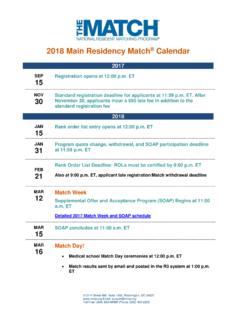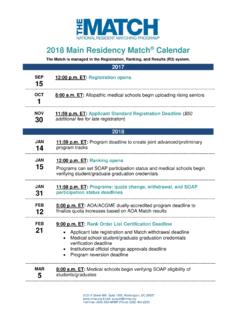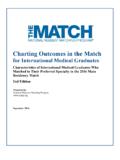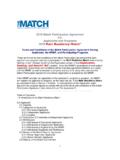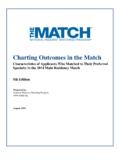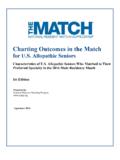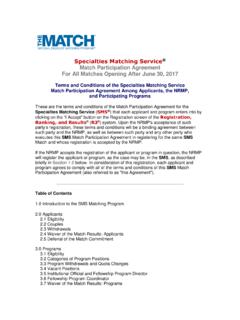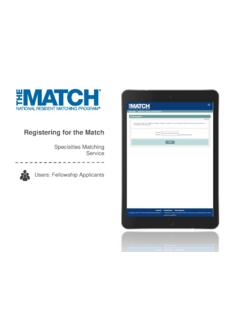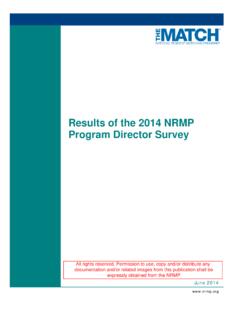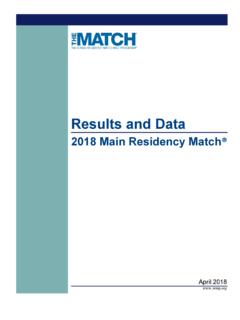Transcription of Charting Outcomes in the Match
1 Charting Outcomes in the Matchfor Osteopathic Medical Students and GraduatesCharacteristics of Osteopathic Medical Students and Graduates Who Matched to Their Preferred Specialty in the 2016 Main Residency Match1st EditionPrepared by:National Resident Matching 2016 Questions about the contents of this publication may be directed to Mei Liang, Director of Research, National Resident Matching Program, (202) 400-2233 or about the NRMP should be directed to Mona M. Signer, President and CEO, National Resident Matching Program, (202) 400-2233 or 2016 National Resident Matching Program, 2121 K Street, NW, Suite 1000, Washington, DC 20037 USA.
2 All rights reserved. Permission to use, copy and/or distribute any documentation and/or related images from this publication shall be expressly obtained from the NRMPN ational Resident Matching Program, Charting Outcomes in the Match for Osteopathic Medical Students and Graduates, 2016. National Resident Matching Program, Washington, DC 2016. 2016 Table of ContentsIntroduction .. ii Tables and Charts for All Specialties Chart 1. Active Applicants in the 2016 Main Residency Match .. 2 Table 1. Number of Applicants and Positions in the 2016 Main Residency Match .
3 3 Chart 2. Ratio of Osteopathic Medical Students and Graduates Ranking Specialty First / Available Positions .. 4 Chart 3. Match Rates of Osteopathic Medical Students/Graduates .. 5 Table 2. Summary Statistics on Osteopathic Medical Students/Graduates .. 6 Chart 4. Median Number of Contiguous Ranks of Osteopathic Medical Students/Graduates .. 7 Chart 5. Mean Number of Different Specialties Ranked of Osteopathic Medical Students/Graduates .. 8 Chart 6. COMLEX-USA Level 1 Scores of Osteopathic Medical Students/Graduates.
4 9 Chart 7. COMLEX-USA Level 2-CE Scores of Osteopathic Medical Students/Graduates .. 10 Chart 8. Mean Number of Research Experiences of Osteopathic Medical Students/Graduates .. 11 Chart 9. Mean Number of Abstracts, Presentations, and Publications of Osteopathic Medical Students/Graduates .. 12 Chart 10. Mean Number of Work Experiences of Osteopathic Medical Students/Graduates .. 13 Chart 11. Mean Number of Volunteer Experiences of Osteopathic Medical Students/Graduates .. 14 Chart 12. Percentage of Osteopathic Medical Students and Graduates Who Have a Graduate Degree.
5 15 Tables and Charts for Individual Specialties Anesthesiology .. 16 Diagnostic Radiology .. 25 Emergency Medicine .. 34 Family Medicine .. 43 General Surgery .. 52 Internal Medicine .. 61 Neurology .. 70 Obstetrics and Gynecology .. 79 Pathology .. 88 Pediatrics .. 97 Physical Medicine and Rehabilitation .. 106 Psychiatry .. 115 iCopyright 2016 NRMP. Reproduction prohibited without the written permission of the Outcomes in the Match for Osteopathic Medical Students and Graduates, 2016 2016 IntroductioniiCopyright 2016 NRMP.
6 Reproduction prohibited without the written permission of the first edition of Charting Outcomes in the Match was published in August 2006 to document how applicant qualifications affectsuccess in the Main Residency Match . The report was published biennially between 2007 and 2011 and was a collaboration of theNational Resident Matching Program (NRMP ) and the Association of American Medical Colleges (AAMC ). Match outcome data from the NRMP were combined with applicant characteristics from the AAMC s Electronic Residency Application Service (ERAS ) and United States Medical Licensing Examination (USMLE ) scores from the AAMC data warehouse.
7 However, starting with the 2014 MainResidency Match , the NRMP added a Professional Profile section to its Match registration process to collect the USMLE scores and otherapplicant characteristics. NRMP has used those data to independently produce this report since the 2014 version of Charting Outcomes inthe Match . In prior years, this report examined the Match success of only two applicant groups: senior students from allopathic medical schools and independent applicants. Independent applicants included all applicant types other than seniors: previous graduates of medical schools, students/graduates of osteopathic medical schools, students/graduates of Fifth Pathway programs,students/graduates of Canadian medical schools, and citizen and citizen students/graduates of international medicalschools.
8 Because independent applicants are a heterogeneous group, a decision was made this year to report data separately for allopathic medical school seniors, students/graduates of osteopathic medical schools, citizen students/graduates of internationalmedical schools, and citizen students/graduates of international medical schools. This report is the first Charting Outcomes in the Match that examines the characteristics of students/graduates of osteopathic medical schools. It is important to note that inaddition to the Main Residency Match , students and graduates of osteopathic medical schools can participate in the Match sponsored bythe American Osteopathic Association (AOA).
9 Applicants who obtain positions in the AOA Match are automatically withdrawn from theNRMP so that they cannot Match to concurrent year success, specialty preference, and ranking information were collected through the Main Residency Match . Other applicantcharacteristics, including academic degrees, publications, and research, work and volunteer experiences, were self-reported through the Professional Profile section of the NRMP s Applicant Registration Form for the Match . To complete the form, applicants were asked toanswer the questions as they reported in their ERAS Common Application Form (CAF).
10 Completion of the form was optional, and applicants who completed the form could consent or decline to participate in NRMP research. Data collection for the self-reportedProfessional Profile section was granted exemption by Chesapeake Institutional Review Board (IRB). Traditionally, Charting Outcomes in the Match reports on USMLE scores. Because the Comprehensive Osteopathic Medical LicensingExaminations (COMLEX-USA) is the licensing examination for osteopathic medical students/graduates, only a small number ofosteopathic medical students/graduates also take the USMLE examination.
